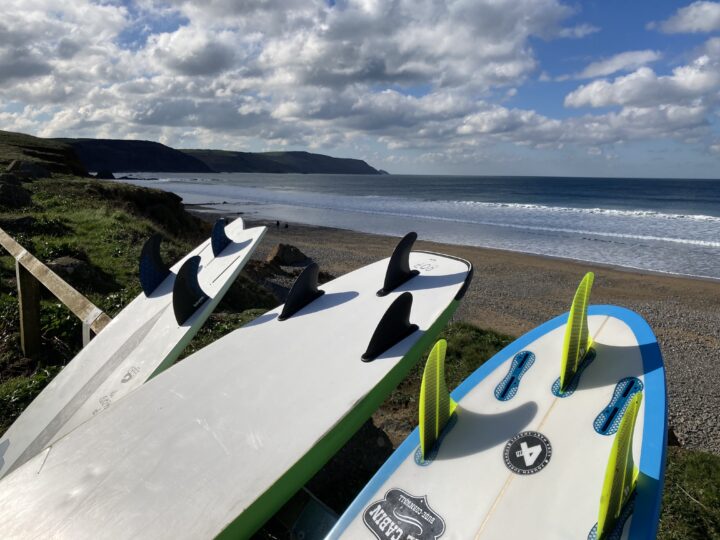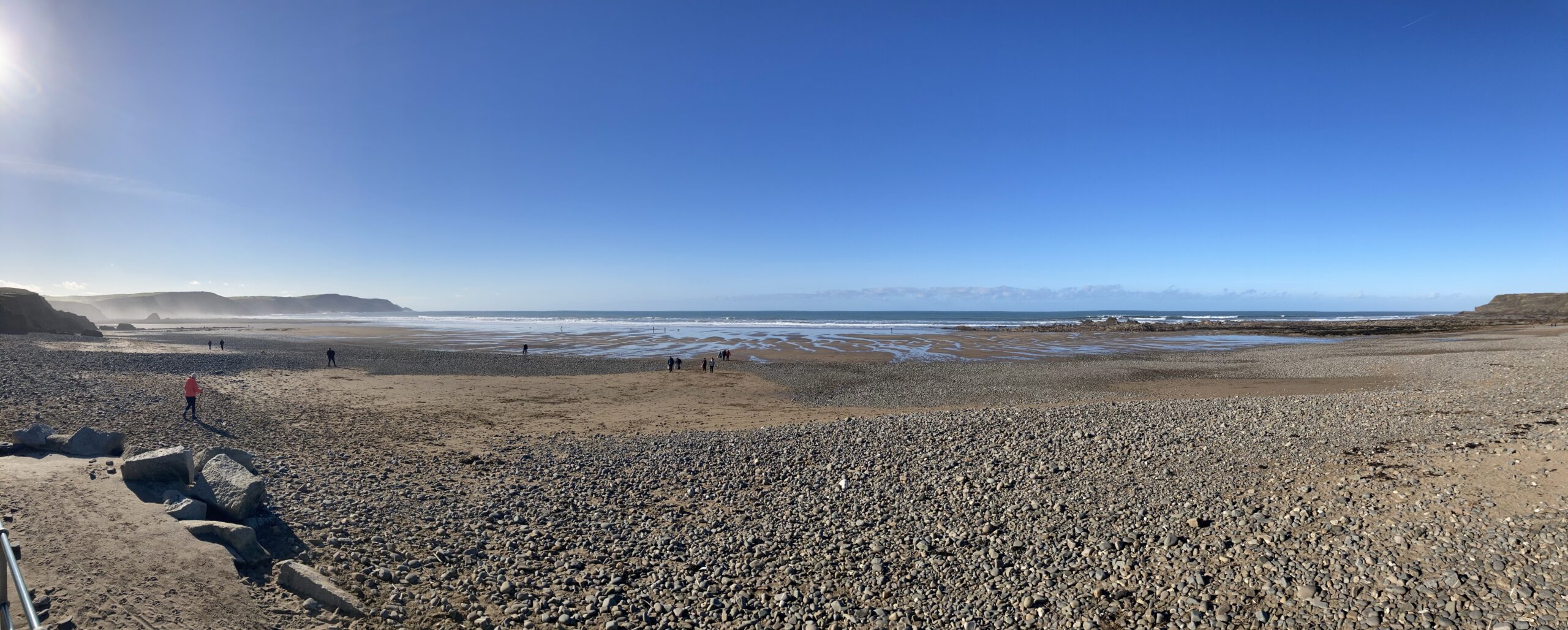Beginners Guide to Surfing at Widemouth Bay in Bude, Cornwall
Widemouth Beach is a very popular for surfing. This is due to the the convenient position of beach carparks, the large beach area and (of course) the waves that break there.
The waves at Widemouth Bay often break more gently than Bude’s other surfing beaches and this is for two main reasons. Firstly, Widemouth Bay is positioned in the corner of Bude’s west facing coastline. This offers the bay some shelter from the brunt of Atlantic swells which often makes the waves smaller and less powerful than other local beaches. The second reason is due to the shape of the bay and low lying areas at the top of the beach. These low lying areas at the top of the beach allow sand (which is blown around by the wind) to escape off of the beach and not be built up at the top. If the sand was prevented from leaving the beach, then it would cause the beach (and waves) to be much steeper and less favourable for those learning. The beach is also large which allows for the sand to move around. This movement of sand caused by the wind and the waves creates sand banks. It’s these sand banks along with the swell that moves over them which dictates the shape, speed and power of the waves. So with less swell and more gently sloping sandbanks means Widemouth Bay is a great place to surf for beginner and intermediate surfers.
Widemouth Bay sits 2.5 miles to the south of Bude town. The large bay is made up of two main beaches both with their own carpark, cafe and toilet facilities. Black Rock Beach sits at the south end of Widemouth Bay and Trelawny Beach to the North. The name Trelawny has all but faded away and Trelawny Beach is now more commonly referred to as Widemouth Beach. Both beaches can be accessed by one another across the sand unless there is a spring high tide where the beaches are cut off from one another.
When is the best time (or tide) to surf at Widemouth Bay?
For beginners, we recommend surfing around 2 hours after high tide and/or 2 hours after low tide. This means the tide will be travelling over the flattest section of the beach at Widemouth Bay, causing the waves to break gently and roll for longer.
The waves are often better in the earlier parts of the morning and the beach is usually quieter so more space for you to enjoy your surf sliding session! Always surf when the beach is lifeguarded. Find out dates and times of when Widemouth and Blackrock Beach is lifeguarded.
All stages of the tide can be a fun time to surf at Widemouth, however this depends on the surf and weather conditions that day. When it is mid tide, we can be confident that this is probably the best and safest time to surf Widemouth Beach.
What surfboard should I ride at Widemouth Beach?

Everyone is different and so your board choice should reflect your ability, aspirations and what you would like to do when your surfing on a wave. As a beginner, we recommend surfing a wide board that has plenty of buoyancy especially in the nose area. The waves at Widemouth Bay can be a little bit softer than other beaches, a board with a little more buoyancy is often a good choice. Longboards, Mini Mal’s and Fish’s are a popular choice of board for surfing at Widemouth Bay. For surfboard and wetsuit rentals checkout our Surf Hire
What dangers should I look out for when surfing in Widemouth Bay?
The lifeguards at Widemouth Bay use black and white chequered flags to create a safe surfing zone. This safe surfing zone is placed away from strong rip currents, rocks and will often be located next to the safe swimming zone marked out by the red and yellow flags. If you are a beginner or intermediate then always surf within this black and white flagged area. If you are unsure about where to go surfing at Widemouth then always speak to a lifeguard before entering the water. Taking a single or course of surfing lessons will help you to understand the basics as well as how to keep yourself and others around you safe while surfing. The Bude RNLI have an Instagram account which gives up to date advice.
How to stay safe when surfing at Widemouth Beach
Here are a few final top tips to staying safe when surfing at Widemouth Beach:
- Surf on a lifeguarded beach at all times (see link for dates/times) and in the safe surfing zone.
- Take some surfing lesson with an accredited surf school.
- Surf with a friend or have someone on the beach that can keep an eye on you.
- Keep your feet on the floor when you are not catching a wave. This will help you to be aware of where you are and to prevent any unwanted drifting.
- Use a suitable surfboard for your ability and a wetsuit that is the correct thickness for the time of year.
- If you are unsure if you should or should not be going in the water then don’t. Seek advice before jumping in.
